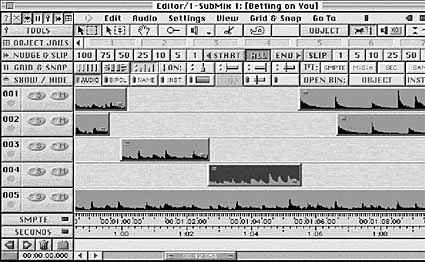
I've always felt vocals had more to do with performance than technical proficiency. Trying to be emotionally engaging while punching in two words on one vocal line is no fun - either as a performer, or when trying to capture someone else's performance. Fortunately, PARIS offers an easy alternative to the formerly difficult practice of "comping" vocals (i.e., creating a "composite" track out of the best bits and pieces of other tracks).
In the analog era, the only way to make a composite vocal was to have lots of tracks available, console automation (or fast fingers with a nimble brain), and very good noise reduction. You'd record a bunch of vocals on different tracks, then listen (repeatedly) to each track and decide which parts to use (while putting more wear and tear on the tape, of course). Then you'd set up automation to bounce the right sections of track, at the right times, to an empty "composite" track.
PARIS's "free form" mode is the solution to easy vocal comping, or any other instrument for that matter. It's easy to record multiple tracks, then pick and choose the best sections to end up with a "perfect" take.
By not doing punches, a vocalist can come in, do some quick, loose takes, then kick back. Singers hate to wait around; it's better to capture the performances while you can and apply the time you save toward "vocal post-production." Comping may sound like it's designed for when you don't really know what you're doing and want to fix it in the mix, but that's not the idea. The intention is to capture spontaneous moments, and then perfect the performance offline.
Auditioning tracks is very easy in PARIS. The top-most track in an Instrument (which contains the free-form tracks) is the only track you will hear. For this reason, I generally move what felt like the best take all the way to the top.
However, if you "peel away" part of that track by cutting out a segment, the next lower track will play. In Fig. 1, note the gap in track 001. After the first part of track 001 plays, the next highest-track is 003. After its segment plays, the segment in track 004 plays. Then track 1 is once more the top-most track, and it plays the remainder of the solo. Track 5 was a lousy take, and nothing from it plays at all because it is never the top-most track.

I generally find that when a person concentrates on copying the original track as closely as possible, the doubled track suffers because the singer isn't concentrating on the performance, but on being "correct." On the other hand, with composite vocals I seldom listen to previous takes while adding new ones; the end results are usually very similar anyway if you've practiced the tunes.
You'll still have occasions where a doubled part is great except for some non-fixable glitch-like the last word sustains more on one take, or one take drops in pitch a bit while the other one stays constant. Here's the fix: copy the piece of audio that does work, and drag it over to replace the one that doesn't. Next, nudge the start point of the copied piece of audio by about 20 ms (forward or backward, it doesn't make much difference). This provides the slight timing difference you expect from doubling, yet the performance will be "perfect" because you're using copied audio. It sounds very cool.
But we're not quite done yet. Listen to the composite vocal several times, then try just one more take. Sometimes this will be as good as the "comped" version, but it will flow better because it was all done in one take. And if it doesn't work, you've lost nothing except a few minutes of your time.
© 1999, Craig Anderton. All Rights Reserved. Used by permission.
By his 22nd birthday, Craig Anderton had recorded three albums with the Philadelphia-based
group "Mandrake Memorial," toured most of the USA, and played at Carnegie Hall. Craig is a
prolific author, having written the classic work Home Recording For Musicians,
several other books, and numerous articles for such magazines as EQ, Guitar Player, Keyboard, Musician, Performing Songwriter, Pro Audio Netherlands, and several others. He
is currently Technology Editor for EQ magazine, Consulting Editor for Guitar Player
magazine, and a monthly columnist for Keyboard.
© 2002 All Rights Reserved E-MU / ENSONIQ